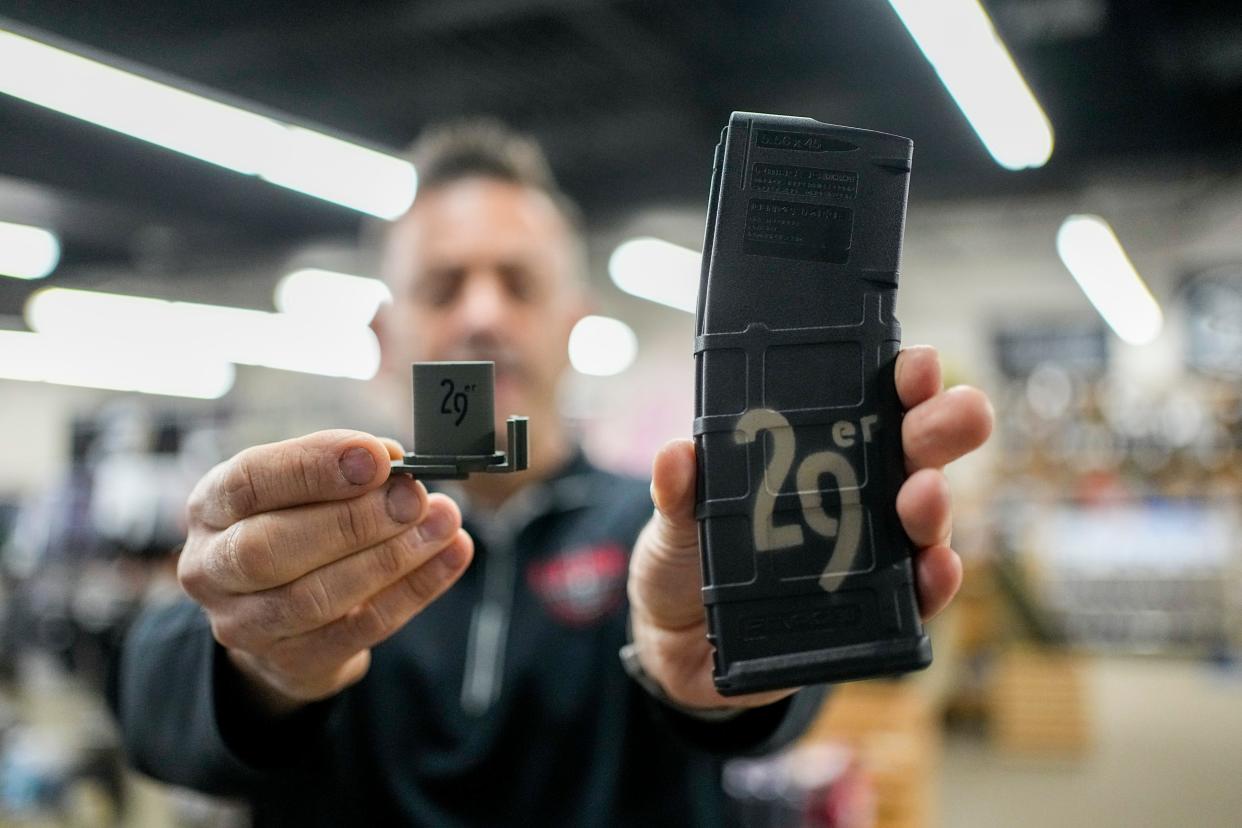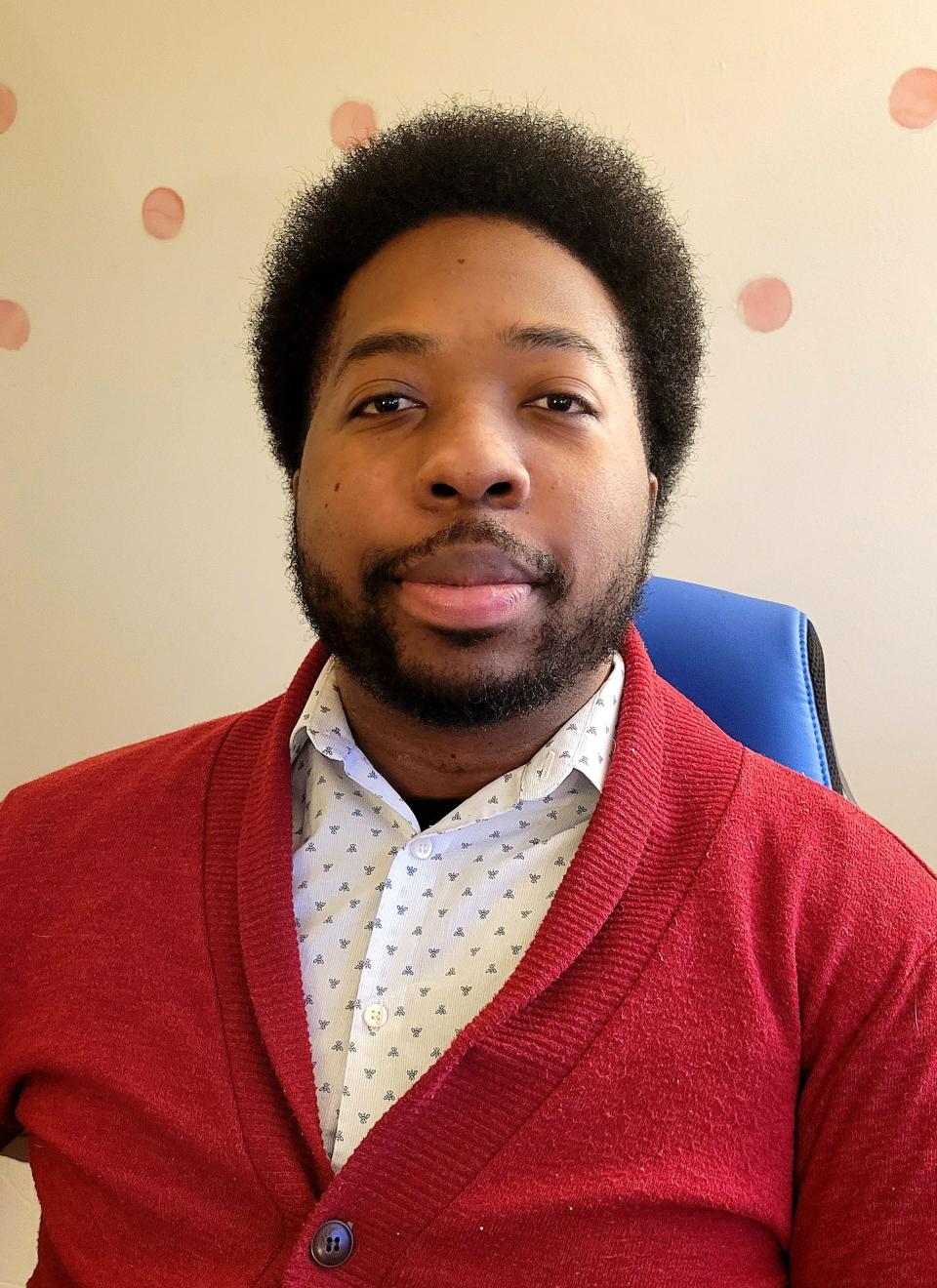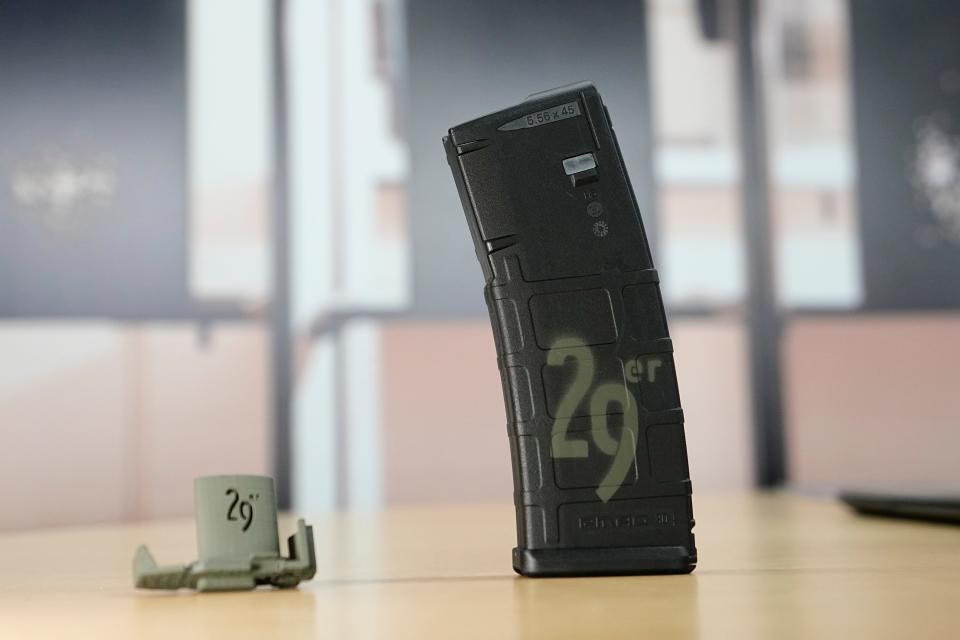The Conversation: How Columbus' large-capacity magazine ban and other measures fall short

Since the beginning of the pandemic and the political turmoil of 2020, the U.S. has seen many historical events regarding gun violence, gun ownership, and gun laws. The nation broke its record for the highest number of homicides two years in a row, President Biden signed legislation expanding the scope of federal gun laws for the first time in nearly three decades, and in 2022 the Supreme Court decided a landmark case that struck down part of New York’s concealed carry law and established a new standard for determining the constitutionality of state gun laws.
The nation also saw numerous high-profile, public mass shootings that dominated headlines and spurred Americans to once again “do something” in their wake. These “somethings” have been the typical policies advocated in the aftermath of tragedies: assault weapon “bans”, expanded background check laws, and in the case of Columbus, large-capacity magazine ban.
In December, Columbus City Council passed new measures that increase the scope of firearm storage laws and prohibit the possession and sale of magazines capable of holding 30 or more rounds of ammunition within city limits beginning July 1st. The 30-round cutoff was chosen due to that being the standard magazine capacity of AR-15s. The City Council, citing the 2019 Dayton mass shooting and other benchmarks of violence in Ohio, declared gun violence a “public health issue" and signaled their intention to tackle it as such. But the criminalization of accessories that can be considered common and readily accessible is hardly a public health approach. It simply widens the net of an already overburdened criminal justice system for an item that makes negligible contributions to the overall picture of everyday gun violence in America.

Public desire for restrictive measures to combat gun violence is highest after a notable mass shooting with an assault weapon, and is typically focused on measures that reflect the weapons or accessories used in that incident. However, even if the restrictive measures were passed on a federal level, the public no longer had access to whatever specified assault weapon or accessory, and criminals didn’t use any legally available alternative, America would still have a major issue with gun violence and still have more than 95% of its annual firearm homicides, according to the Pew Research Center.
A true public health approach requires us to look at the available evidence and think critically about paths to reduce risk for injury in ways that recognize common patterns that lead to harm, develop ethical interventions to mitigate that risk, and ensure those interventions are sustainable.
If mass shootings are the reason behind declaring gun violence a “public health issue," then counterintuitively one needs to focus less on the high-profile shootings that dominate news cycles. This isn’t because they aren’t important, it’s because even though they garner the most attention, they are anomalies with almost no predictable patterns and are a low percentage of all instances that can be considered “mass shootings”.
Two types of mass shootings are most common, and they both typically take place with handguns that would never be subject to assault weapon bans or similar restrictive legislation. The first type involve domestic violence-related incidents, where in the vast majority of cases a male targets his current or former partner and their/her children. The second most common type involve shootouts between multiple individuals in small subsets of urban neighborhoods where most American gun violence takes place. These predominantly Black neighborhoods have typically been subject to decades of segregationist policies that have left them disinvested and deprived of necessary socioeconomic resources and prone to recurring cycles of crime and violence. City leaders across the nation have the means and resources to truly address domestic violence and urban violence as public health issues by addressing the causes — in other words, by treating the illness and not the symptoms. It is essential for gun violence to be addressed locally because it is mostly concentrated in small, historically segregated areas of major cities.

It is always sad to see instances of mass gun violence on the news. But for Black Americans in or from neighborhoods most affected by gun violence, it can also be disheartening or angering to have their statistics mixed in and presented only in the backdrop of violent crimes affecting mostly young, white victims. A statistic that is being cited more frequently since the Uvalde, Texas school shooting is that since 2020 the leading cause of death for school-aged “children” in the U.S. is gun violence, instead of car accidents as is the case for children in other wealthy nations. However, this is misleading because it excludes deaths from congenital conditions and includes 18- and 19-year-olds, who are more likely to be involved in violent crime than younger children. This statistic is also only true for Black children. The leading cause of death for children of all other races, like children in other nations, is still car accidents. Columbus City Council continues the trend of using Black gun violence victims to justify the passing of new restrictive measures, even though the local communities most affected by violence will not see any benefit from them.
Black Americans are also aware that the enforcement of strict gun laws falls disproportionately on Black neighborhoods and fuels mass incarceration, which paradoxically perpetuates cycles of community instability and violence.
The caseloads of prosecutors and public defenders had been on an unsustainable pace even a decade prior to the surge in homicides during the pandemic, and had the potential to reach “crisis” levels as defendants accused of nonviolent crimes, like illegal gun possession, sat in jail for months and sometimes years before having their cases heard. This crisis has begun to manifest in the last few years as nationwide prosecutors leave their positions in the face of “inhumane” caseloads and increasing amounts of responsibilities, sometimes leaving district attorney’s offices with nearly half of their previous staffing levels.
Some prosecutors are choosing to not pursue some misdemeanor gun charges and are prioritizing diversion programs as they would be unable to focus on actual violent crime due to the volume of individuals being arrested on a single charge of a nonviolent gun crime (e.g., illegal possession, failure to register a firearm). Since the pandemic began, some major cities have seen substantial increases for gun possession arrests, but have failed to see any correlating decline in gun homicides. As conservatives call for a return to typical “tough-on-crime” approaches and progressives advocate for more expansive gun laws, the public needs to recognize that this criminal justice system focus is unsustainable and is tearing communities apart. Implementing new policies that target commonly possessed items is unenforceable without using practices that are invasive and unfairly target individuals in vulnerable communities.
In explaining how the magazine ban is to be enforced, Columbus City Attorney Zach Klein said that police won’t be going door to door to confiscate them, and pointed to protests from the summer of 2020 where white civilian militias armed with AR-15s were present and involved in activities that could be seen as intimidation. He stated that the ordinance could be a deterrence to such activity in the future, as police can make arrests upon spotting the magazines. However, that doesn’t account for Black protesters who showed up similarly armed for their own protection or Black residents simply protecting their own businesses and neighborhoods. The law does give a slight exemption for traveling through the city for “lawful purposes”, which might be some relief for Black gun owners who might need to drive through Columbus city limits to get to gun ranges in cities that allow the use of these magazines. However, open-ended laws like this still create the potential for biased officers to decide which drivers they want to target and arrest for possession. The dismissive attitude of telling the public that the ordinance won’t be enforced by going door to door should invoke skepticism from Black people who are all too familiar with traffic-stop practices, which disproportionately affect Black drivers, and stories of otherwise law-abiding Black gun owners pulled over and arrested for traveling with items that were legal in the place they departed from.
An additional detail of the Columbus law should also concern the public. And that is, who is exempt from the prohibition of 30-round magazines. The law has the typical exemptions for law enforcement officers and those who work in certain certified security positions. However, there are also exemptions for ordinary members of the public. Civilians who have paid hundreds of dollars in taxes to own a firearm that is regulated under the National Firearm Act (NFA) are exempt from the law. NFA items are sawed-off shotguns and rifles, silencers, and fully automatic machine guns. Columbus has specifically identified these firearms as “dangerous ordnance," but has exempted them and their owners from enforcement of the magazine ban. This exemption further will inevitably increase the gap in equitable enforcement of the law because it explicitly grants immunity to individuals who simply pay a tax to the federal government.
The Columbus ordinance (which will come into effect during a city election year) can be viewed as self-defeating as it contains a provision to define “large-capacity” magazines as magazines holding 100 rounds instead of 30 rounds if a court overturns that portion of the law. Passing a law that grants exemptions to people willing to pay hundreds of dollars and has a fail-safe measure because city officials know it is likely to be overturned by some court is not cause for celebration. It should invoke criticism from the public and generate pressure for City Council to put in the work to create lasting solutions, not temporary fixes during election years.
The public should also view the ordinance in light of the Supreme Court decision that radically changed New York’s restrictive firearm licensing laws last year. When New York state attorneys were confronted under oath in court about how their strict gun laws contribute to public safety, they struggled to give a satisfactory explanation of the costs and benefits of their enforcement and if enforcement was equitable across the state. Legislators also tried to make amendments to the law being examined so the case would be dismissed, all to no avail. As a result, not only was New York forced to change their law, but states with similar licensing laws also had to fall in line with the new federal standard. We are still learning how this decision, resulting from overly restrictive gun laws, could potentially limit options for states and localities to adopt restrictive measures in the future. A local lawsuit should make the City Council think very carefully about the implications of a failed attempt to pass and enforce a restrictive measure that is popular with voters nationally.
Columbus has adopted some true public health approaches recently that do deserve recognition, but must also be reminded of the systemic issues with the enforcement of restrictive gun laws. Local leaders should continue to focus on implementing or building upon proven community-based interventions that have historically had positive results in the areas they are implemented. Violence interruption programs, like Cure Violence, Safe Streets, and other inspired programs, have demonstrated the value of having community members intervene in volatile situations before they escalate into gun violence. In some places, they have been able to give hope to their communities by helping to reduce homicides (as much as 43% and 63% in some neighborhoods), as well as provide employment and other resources to at-risk youth. Some leaders of these stressful, underfunded, and sometimes dangerous programs have also pointed out that this type of work isn’t all that is needed to prevent gun violence, as they are not equipped to deal with the poverty and other community conditions that create the cycles of violence in these neighborhoods. They also partner with other nonprofit organizations to provide mental health services, food security, and other needed resources.

The City of Columbus can expand partnerships with local groups that are already active in community improvement projects, housing projects for homeless individuals and victims of intimate partner violence, and violence prevention efforts to directly address local issues. This approach can be impactful because these groups are already aware of the needs of their local communities and have the knowledge and relationships needed to effectively fulfill those needs; however, they might not have the resources needed to accomplish their goals. Using grants, law enforcement partnerships, or other resources to aid the efforts of these small, local groups that have already been identified and are working on problems has the potential to create the biggest impact in neighborhoods that need the most resources. Some researchers estimate that for every 10 additional local nonprofits focusing on violent crime and community building in major cities across the U.S., there is an associated 9% decrease in homicide rates and 6% decrease in violent crime rates.
These nonpunitive measures need to be prioritized by any public officials claiming gun violence is a public health issue. This can be difficult because this approach is not popular with the public, which typically prefers to stick with traditional gun control measures that have not worked and have contributed to the incarceration of far too many nonviolent people of color for not paying special taxes and licensing fees to be armed.
The discussion of gun rights versus gun control is a sensitive subject and can be very divisive, but tends to lack nuance. The public needs to be informed of what everyday gun violence looks like and needs to recognize and reject the trend of public officials overlooking the most affected communities and victims in the pursuit of restrictive gun safety measures. Real, sustainable change will take real, sustained effort. And money. Lots of money. Undoing years of systemic issues will not be easy and will not happen overnight. It will alienate voters who value “tough-on-crime” approaches because they want to feel safe going out in public, and might offend police departments who have become accustomed to prioritizing the enforcement of gun laws instead of closing out gun homicide cases. But real change is attainable and will be worth it.
Johnny Dudley is a clinical research coordinator at Nationwide Children's Hospital who is passionate about social justice issues and criminal justice system reforms. He enjoys playing music, making pizzas, and spending time with his wife and daughter.
This article originally appeared on The Columbus Dispatch: The Conversation: Columbus' large-capacity magazine ban misses target

